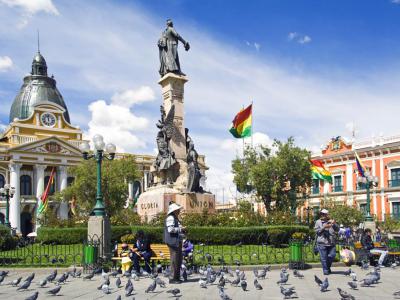Pedro Domingo Murillo Monument, La Paz
The Pedro Domingo Murillo Monument is a significant landmark that holds historical and symbolic significance for the country. Located in Plaza Murillo, the heart of the city's political and administrative center, the monument commemorates Pedro Domingo Murillo, a leader of the Bolivian independence movement.
The centerpiece of the monument is a sculptured image of a woman, symbolizing the Mother Country. This representation embodies the nation's identity and signifies the strength and resilience of the Bolivian people. The woman stands tall on the pedestal, evoking a sense of pride and patriotism.
Adjacent to the female figure is a soldier liberating a bronze lion, which serves as a symbol of bravery and victory. This depiction embodies the struggles and sacrifices made by the Bolivian people during their fight for independence. It represents the courage and determination of the nation's heroes who fought for freedom and sovereignty.
The story of the monument itself is intertwined with a tale of resilience. During its transportation from Italy, the cargo ship carrying the monument sank, resulting in the loss of some parts. However, despite this setback, the monument was reconstructed, and the surviving components were assembled to create the present-day structure.
Over time, the Plaza Murillo underwent further embellishment. Marble female figures representing the four seasons-Summer, Winter, Fall, and Spring-were placed in the vicinity of the monument. These figures symbolize the cyclical nature of life and the passing of time, adding a touch of natural beauty to the plaza.
Additionally, the plaza features four muses representing the arts: Painting, Architecture, Music, and Sculpture. Each muse represents a distinct artistic discipline, celebrating the importance of art in shaping the nation's identity.
The centerpiece of the monument is a sculptured image of a woman, symbolizing the Mother Country. This representation embodies the nation's identity and signifies the strength and resilience of the Bolivian people. The woman stands tall on the pedestal, evoking a sense of pride and patriotism.
Adjacent to the female figure is a soldier liberating a bronze lion, which serves as a symbol of bravery and victory. This depiction embodies the struggles and sacrifices made by the Bolivian people during their fight for independence. It represents the courage and determination of the nation's heroes who fought for freedom and sovereignty.
The story of the monument itself is intertwined with a tale of resilience. During its transportation from Italy, the cargo ship carrying the monument sank, resulting in the loss of some parts. However, despite this setback, the monument was reconstructed, and the surviving components were assembled to create the present-day structure.
Over time, the Plaza Murillo underwent further embellishment. Marble female figures representing the four seasons-Summer, Winter, Fall, and Spring-were placed in the vicinity of the monument. These figures symbolize the cyclical nature of life and the passing of time, adding a touch of natural beauty to the plaza.
Additionally, the plaza features four muses representing the arts: Painting, Architecture, Music, and Sculpture. Each muse represents a distinct artistic discipline, celebrating the importance of art in shaping the nation's identity.
Want to visit this sight? Check out these Self-Guided Walking Tours in La Paz. Alternatively, you can download the mobile app "GPSmyCity: Walks in 1K+ Cities" from Apple App Store or Google Play Store. The app turns your mobile device to a personal tour guide and it works offline, so no data plan is needed when traveling abroad.
Pedro Domingo Murillo Monument on Map
Sight Name: Pedro Domingo Murillo Monument
Sight Location: La Paz, Bolivia (See walking tours in La Paz)
Sight Type: Attraction/Landmark
Guide(s) Containing This Sight:
Sight Location: La Paz, Bolivia (See walking tours in La Paz)
Sight Type: Attraction/Landmark
Guide(s) Containing This Sight:
Walking Tours in La Paz, Bolivia
Create Your Own Walk in La Paz
Creating your own self-guided walk in La Paz is easy and fun. Choose the city attractions that you want to see and a walk route map will be created just for you. You can even set your hotel as the start point of the walk.
La Paz Monuments Tour
They say monuments are the grappling irons that bind one generation to another, symbolizing the country's aspirations, its past, and its character. The monuments in La Paz do exactly that, holding profound cultural, historical, and symbolic value.
The prominent statue of Pedro Domingo Murillo in Plaza Murillo commemorates the key figure of the La Paz revolution of 1809, one of the chapters... view more
Tour Duration: 1 Hour(s)
Travel Distance: 0.8 Km or 0.5 Miles
The prominent statue of Pedro Domingo Murillo in Plaza Murillo commemorates the key figure of the La Paz revolution of 1809, one of the chapters... view more
Tour Duration: 1 Hour(s)
Travel Distance: 0.8 Km or 0.5 Miles
La Paz Introduction Walking Tour
Nestled like a jewel within the cradle of the Andean highlands, over 3,500 meters above sea level, La Paz, Bolivia, is the most elevated capital city in the world. Curiously, it is one of Bolivia's two capitals (the other one is Sucre).
La Paz was founded on the site of a small Inca settlement, in 1548, by the Spanish conquistador Alonso de Mendoza, and was originally named Nuestra Señora... view more
Tour Duration: 2 Hour(s)
Travel Distance: 2.8 Km or 1.7 Miles
La Paz was founded on the site of a small Inca settlement, in 1548, by the Spanish conquistador Alonso de Mendoza, and was originally named Nuestra Señora... view more
Tour Duration: 2 Hour(s)
Travel Distance: 2.8 Km or 1.7 Miles





